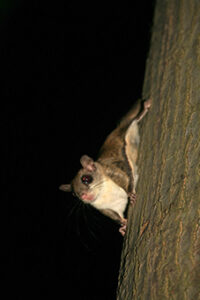Squirrels are essentially everywhere in Ohio. They’re so common, they’re almost invisible — most people don’t think twice when they encounter one. But successfully flourishing alongside humans without intensive management is somewhat of a remarkable feat in 2021 — one that few wildlife species can lay claim to.
Upon closer look, squirrels provide a fascinating glimpse into forest ecosystems in Ohio, and the rodents have plenty of unique traits worthy of our attention. Here are five things to know about Ohio squirrels:
1. The southern flying squirrel is the most common of Ohio’s squirrel species, according to the Ohio Department of Natural Resources, though the animals mostly live in the southeast part of the state and are rarely seen because they’re nocturnal.

No, flying squirrels can’t actually fly, but skin flaps between their wrists and ankles allow them to glide through the trees with even more of an airborne grace than their fellow squirrel relatives, said Marne Titchenell, wildlife program specialist at The Ohio State University Extension. Their jumps can span several hundred feet, though around 30 feet is typical.
“As they’re mostly nocturnal, the best way to find [flying squirrels] is to listen at night to their calls. They make a high-pitched, single chirp or squeak, and they often repeat it,” Titchenell said. Those more ambitious can set up a trail camera or use a red spotlight during night hikes, she said.
Slightly smaller than tree squirrels Ohioans usually see, flying squirrels are less common in suburbs and prefer dense deciduous wooded areas. Unlike other tree squirrels, flying squirrels huddle up with each other in large masses during winter in tree cavities, which they also use to store food — up to thousands of nuts a season, Titchenell said.
2. Squirrels are vastly important to natural forest regeneration. Eastern gray and eastern fox squirrels — both widespread in Ohio and native only to eastern North America — store nuts and seeds by burying them in various locations to return to later, a method called scatter hoarding. Because many food items will never be recovered, some germinate and grow into new trees.
“Squirrels’ caching behavior can serve as an important conduit for regeneration of certain tree species, specifically hard mast-producing species like oaks,” said Mark Wiley, wildlife biologist at the Ohio Department of Natural Resources Division of Wildlife.
Chipmunks, a ground squirrel, “create extensive underground tunnels that have been implicated in the spread of mycorrhizal fungi, which can benefit tree roots,” Titchenell said.
3. Black squirrels in Ohio are providing researchers an in-depth look at fundamental evolutionary processes. A 2020 study in the journal Ecology and Evolution led by College of Wooster professor Rick Lehtinen mapped out nearly 70,000 squirrel sightings in the Great Lakes region to determine the prevalence of black or “melanistic” squirrels — which are gray squirrels with a unique genetic trait for black fur. The geographic patterns revealed in the study can help inform scientists’ understanding of genetic drift and evolutionary change. (There are also white squirrels in Ohio)
4. Squirrels communicate with their tails — and greet like the French.
“They may fluff their tail when disturbed and flick it when distressed or alarmed,” Titchenell said. “Tail shivering conveys nervousness, and tail waving side to side generally accompanies social greetings or nonaggression.”
Some squirrels, including gray squirrels, fox squirrels and woodchucks, greet each other by smelling secretions from glands in the corners of their mouths, which looks a lot like kissing, Titchenell added.
5. Habitat loss is one of the biggest potential threats to Ohio squirrels. Squirrel populations in Ohio are healthy and robust, Wiley said, but long-term threats include habitat degradation and loss.
“This could include conversion of forest cover to other cover types, or a change in forest composition, specifically a loss of hard mast-producing species like oaks,” Wiley said.
Promoting the growth of oak and hickory trees is important in Ohio, where forests are becoming dominated by maples, said Titchenell, adding there are ongoing collaborative efforts to regenerate oaks.
“Squirrels are an important prey species for mammalian and avian predators in Ohio,” Wiley said. “Without squirrels, we would expect populations of many of Ohio’s hawks, owls and mammals to decline. It is also possible that predation pressure could shift to other prey species, possibly causing further disruption of the existing food chain.”
To conclude, squirrels have a lot going for them, but they won’t say no to a little help.
“Folks can help by promoting oak-hickory forests, which provide food and shelter to squirrels. They can also put out nest boxes to provide habitat for flying squirrels,” Titchenell said. “Keeping cats inside is another great recommendation to keep small wildlife safe.”

Comments are closed